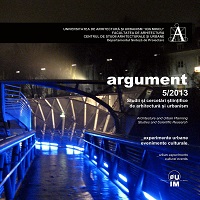EXPERIMENT URBAN – ANALIZĂ ŞI EXPRESIE
URBAN EXPERIMENT – ANALYSIS AND EXPRESSION
Author(s): Anca MitracheSubject(s): Education, Architecture, Higher Education
Published by: Editura Universitară “Ion Mincu”
Keywords: public space; private space; urban experiment;
Summary/Abstract: An architectural object embodies the interaction between matter and the definition of matter. Construction is guided by language throughout the stages of its completion. Siegfried Giedion once said that space was the mother tongue of architects. This association has helped architecture students devise their first architectural responses to a real site. The design exercise suggested by the 2nd year studio took place in the historic centre of the capital. Charlie Simic’s “Street Corner Theology” was our constant companion during the project: “The disorder of the city is sacred. All things are interrelated. As above, so below. We are fragments of an unutterable whole.” Simic also said that “Meaning is always in search of itself. Unexpected revelations await us around the next corner.” At the Faculty of Architecture, during the third semester of study, the design exercise suggested by our Design Studio is part of a broader process of systematic study and acquirement of the knowledge, theoretical constructs, skills and practices indispensable to future architects. The skill set students must develop during the 2nd year of study includes notions about shaping the architectural object, data referring to the understanding of the natural processes that support human life and, naturally, information having to do with context. A reading of the site on which architectural objects are to be placed is the key starting point of the project. This entails knowledge of the data necessary for the analysis of the site and the understanding of the natural processes of human life, activities and inter-personal relationships. Next, each student formulates a personal response, specific to their own perception and reading of the site. By exploring the expressive potential of shape and materials, the combined effect of reading and perception materializes into an architectural object. The analysis and understanding of spatial shape indicate to the students the fact that an architectural object is a complex unit defined by a structure and a specific material, both in close connection with the intended site of the object. While searching for an architectural language, our efforts transform both the noticeable and the imperceptible edges of the site’s sphere of influence, illustrating the link between human activity, architecture and the present.
Journal: Argument
- Issue Year: 2013
- Issue No: 5
- Page Range: 79-93
- Page Count: 15
- Language: English, Romanian

